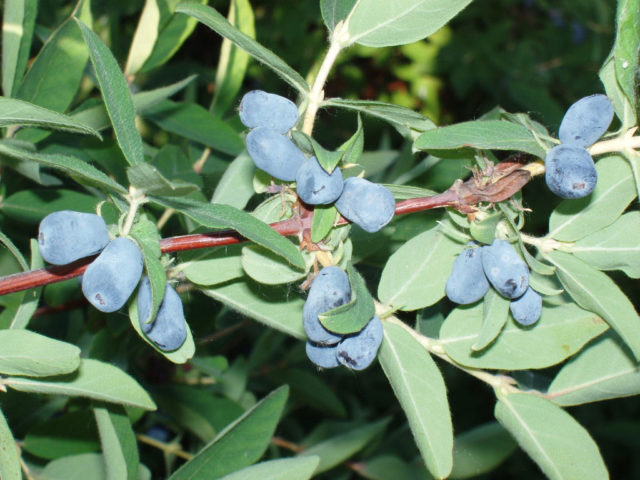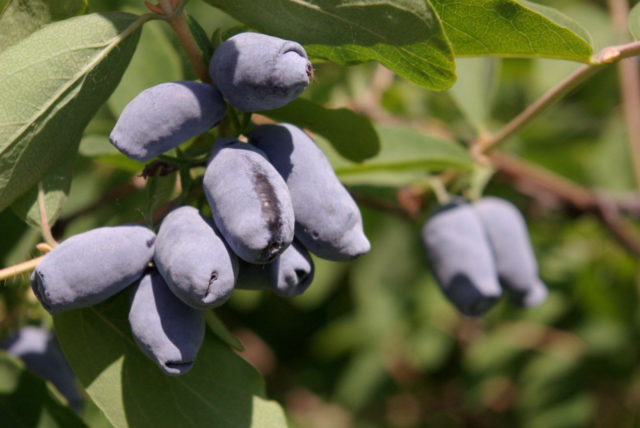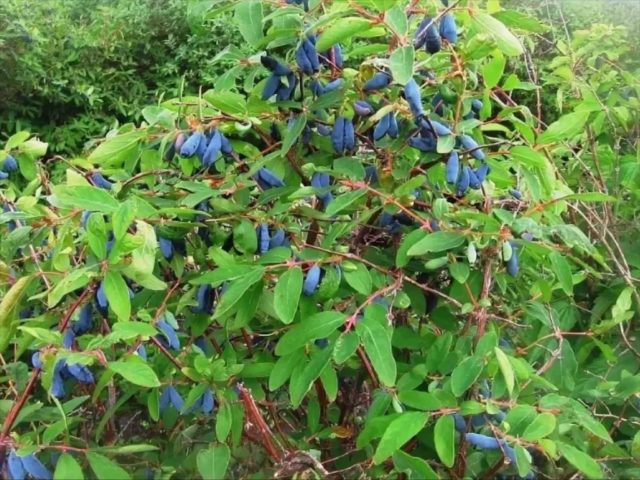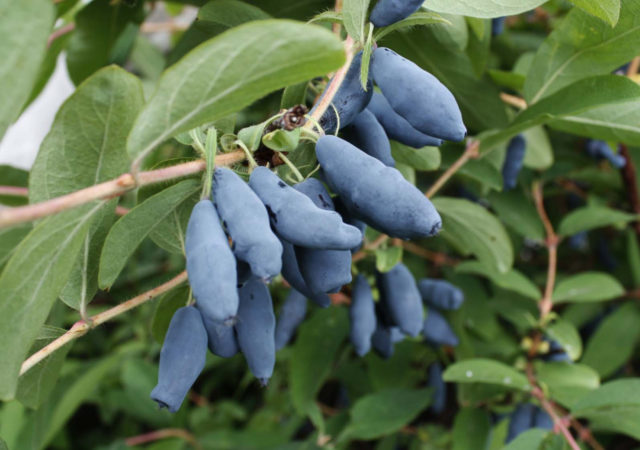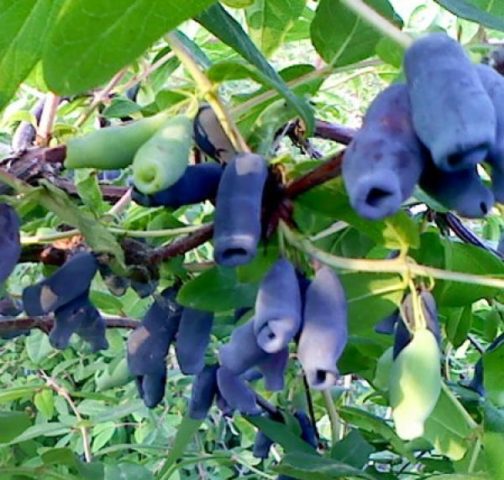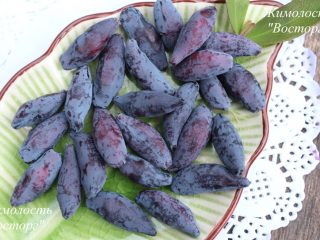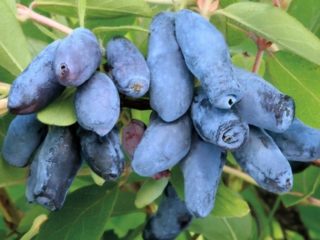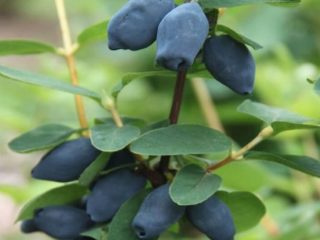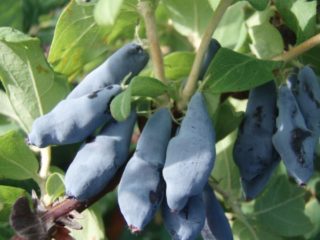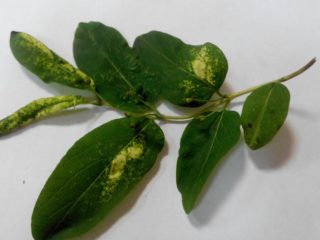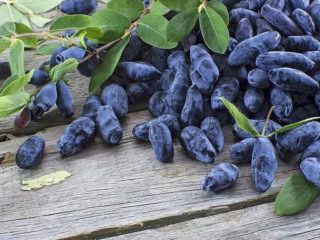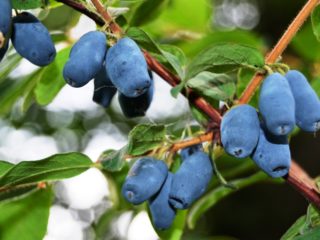Content
Photos and descriptions of the Lazurnaya honeysuckle variety will help beginning gardeners decide whether this variety is suitable for them. One of the main advantages of the shrub is its high resistance to fruit shedding, which formed the basis of its popularity. In addition, it differs from many related varieties in its excellent immunity and immunity to fungal diseases.
Description of honeysuckle variety Lazurnaya
Honeysuckle Lazurnaya is a medium-ripening variety bred by Siberian breeders of the Barnaul NIISS. The first berries appear on the bush only on June 20-24. Fruiting lasts about a month, but if the year is warm, it may bloom a second time. If this happens, there may be no harvest next year.
The Lazurnaya variety is classified as medium-sized - the bush grows on average to 1.5-1.7 m in height. The crown of the shrub is obverse-conical, with thin, non-pubescent shoots of light green color. If the summer is sunny, they may acquire a pinkish tint.
The leaves of the honeysuckle variety Lazurnaya are large and oval in shape, as can be seen in the photo below. The berries are slightly elongated, with a thickening in the middle. The weight of the fruit can reach 1.5 g. The skin of the berries is dark blue, with a bluish coating on the surface. The pulp is tender, with a pleasant sweet and sour taste and blueberry aroma.
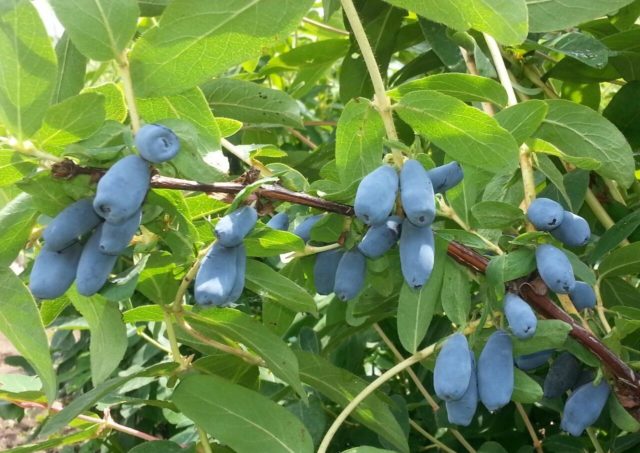
Unlike most varieties, the berries of Azure Honeysuckle do not fall off immediately after ripening, which makes them much easier to harvest
Planting and caring for honeysuckle Lazurnaya
The most important thing when planting honeysuckle is that the seedling should never be buried too far into the ground. Such a bush will grow slowly and bear little fruit.
It is equally important to maintain the distance between neighboring bushes. The recommended planting scheme for the Lazurnaya variety is 1.5-2 m, no less. More concentrated planting will result in plants competing for water and nutritional resources, which will negatively affect the fruiting of seedlings.
How to choose a landing site
This variety is not particularly picky about soil composition, but the plant prefers light, slightly acidic soil. Places with slightly podzolized and loamy soil are also suitable.
As for the level of illumination, preference should be given to open areas. In the sun the berries turn out large and tasty, while in the shade the fruits become smaller and then become very sour.
Watering
Water the plantings regularly, but moderately. Plants should not be overwatered to avoid causing rotting of the roots.The optimal frequency of watering is 1-2 times a week, and no more than 1 bucket of water is spent on each bush. You can moisten the soil both in the morning and in the evening.
Stagnation of water is detrimental to the root system of honeysuckle, therefore, if groundwater lies too high in the area, it is necessary to lay out a drainage layer at the planting site.
Feeding
The Lazurnaya variety is usually fertilized in spring and autumn. First, organic and mineral mixtures with a high content of nitrogen and potassium (humus, horse humus, superphosphate, potassium salt) are used as fertilizers. In the autumn months, wood ash is added to the soil.
Trimming
From time to time, Honeysuckle Azure needs to be pruned to increase the yield of the bush and the size of the fruit. For the first time, the shoots are shortened before planting the seedling so that it branches better. Annual pruning is usually carried out in the spring, when the buds begin to bloom, but it is also possible to form a shrub in the fall.
Branches are pruned so that stumps about 30-40 cm long remain. All weak, dried out or broken shoots must be treated. Branches growing inside the bush are also removed to avoid thickening.
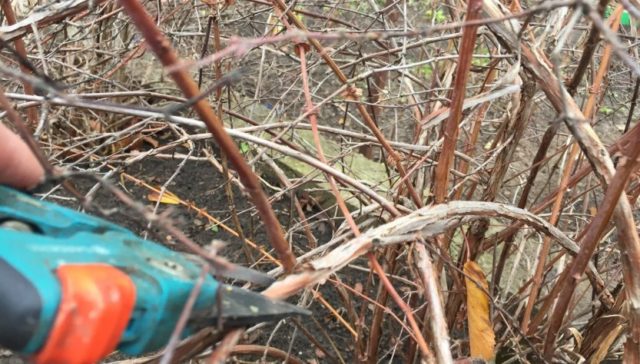
In the spring, you need to inspect the bush and cut off all frozen branches.
Preparing for winter
Despite the fact that honeysuckle of the Lazurnaya variety is a winter-hardy variety, it would be a good idea to cover young bushes for the winter. To do this, it is enough to mulch the tree trunk circle with horse humus.Young bushes can be additionally sprinkled with straw and spruce branches - they will protect the root system of honeysuckle from severe frosts in a snowless winter.
Pollinators of honeysuckle Lazurnaya
All varieties of honeysuckle require cross-pollination, and the Lazurnaya variety is no exception to this rule. Despite the fact that the shrub is partially self-fertile, to obtain a good harvest it is necessary to plant several more bushes nearby. The following species go well with Honeysuckle Azure:
- Gerda;
- Cinderella;
- Blue bird;
- Blue spindle;
- Long-fruited.
Reproduction of edible honeysuckle Lazurnaya
The most effective method of propagating honeysuckle variety Lazurnaya is green cuttings. The whole process can be divided into the following stages:
- As soon as the bush fades, the cuttings are cut from the honeysuckle along with the base (heel). You can also start harvesting cuttings during the formation of fruit ovaries. As a result, each shoot should have at least 4 buds.
- The next step is to soak the resulting blanks in a solution of a root formation stimulator. It is enough to keep the cuttings in it for a couple of hours.
- Then they begin to prepare the soil for planting material. To do this, mix peat with soil in a ratio of 1:3. For prevention purposes, it is recommended to treat the soil with any industrial fungicide.
- When the soil is ready, the cuttings are buried in individual containers with a slope of 30-40 °.
- After this, the soil is abundantly moistened and the workpieces are covered with glass.
- Throughout its growth, the Lazurnaya honeysuckle planting material must be carefully looked after - ventilate the seedlings from time to time and water it moderately. After 2 weeks, the cuttings will begin to form their own root system.
- By August, honeysuckle seedlings should form sufficiently developed roots. After that, they are placed in a school for growing up.
At this point, the process of propagation of honeysuckle variety Lazurnaya can be considered complete. Young bushes are regularly watered and mulched with peat. With the onset of the first frost, the plantings are covered with spruce branches and straw. In August next year, Honeysuckle Azure can be transplanted into open ground.
You can learn more about how to propagate honeysuckle from the video below:
Diseases and pests of honeysuckle variety Lazurnaya
Like many varieties of honeysuckle, this species rarely gets sick. The plant is highly resistant to pathogens of various diseases, while harmful insects also avoid plantings. Only aphids and honeysuckle borers pose some danger to the Azure honeysuckle, but any industrial insecticide can easily cope with them.
Conclusion
Photos and descriptions of the Lazurnaya honeysuckle variety will help you decide whether this variety is worthy of placement in your garden plot. The shrub differs from many other species in its high frost resistance, excellent immunity to most diseases and is practically not affected by pests. Its relative unpretentiousness makes this variety extremely attractive to beginners.
